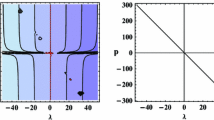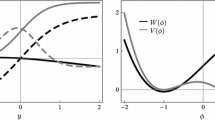Abstract
We consider the Randall–Sundrum model with two branes in which the fields of the Standard Model are localized on the brane with negative tension and the gravitational field and an additional stabilizing scalar Goldberg–Wise field propagate in the space between the branes. We construct a Lagrangian for scalar fluctuations of the gravitational and scalar fields against the background solution. We obtain an effective four-dimensional Lagrangian describing nonlinear self-coupling terms of the scalar radion field in a polynomial approximation up to the fourth order and also nonlinear terms of the coupling of the radion and Standard Model fields. We estimate possible values of the self-coupling constant.
Similar content being viewed by others
References
L. Randall and R. Sundrum, “Large mass hierarchy from a small extra dimension,” Phys. Rev. Lett., 83, 3370–3373 (1999); arXiv:hep-ph/9905221v1 (1999).
W. D. Goldberger and M. B. Wise, “Modulus stabilization with bulk fields,” Phys. Rev. Lett., 83, 4922–4925 (1999); arXiv:hep-ph/9907447v2 (1999).
O. DeWolfe, D. Z. Freedman, S. S. Gubser, and A. Karch, “Modeling the fifth dimension with scalars and gravity,” Phys. Rev. D, 62, 046008 (2000); arXiv:hep-th/9909134v4 (1999).
E. E. Boos, I. P. Volobuev, Yu. S. Mikhailov, and M. N. Smolyakov, “Linearized gravity in the Randall–Sundrum model with stabilized distance between branes,” Theor. Math. Phys., 149, 1591–1603 (2006).
E. Boos, S. Keizerov, E. Rahmetov, and K. Svirina, “Higgs boson-radion similarity in production processes involving off-shell fermions,” Phys. Rev. D, 90, 095026 (2014); arXiv:1409.2796v1 [hep-ph] (2014).
E. Boos, S. Keizerov, E. Rakhmetov, and K. Svirina, “Comparison of associated Higgs boson–radion and Higgs boson pair production processes,” Phys. Rev. D, 94, 024047 (2016); arXiv:1604.00998v2 [hep-ph] (2016).
E. E. Boos, Yu. S. Mikhailov, M. N. Smolyakov, and I. P. Volobuev, “Energy scales in a stabilized brane world,” Nucl. Phys. B, 717, 19–33 (2005); arXiv:hep-th/0412204v2 (2004).
E. E. Boos, V. E. Bunichev, M. A. Perfilov, M. N. Smolyakov, and I. P. Volobuev, “Higgs–radion mixing in stabilized brane world models,” Phys. Rev. D, 92, 095010 (2015); arXiv:1505.05892v3 [hep-ph] (2015).
Acknowledgments
The authors express their gratitude to E. E. Boos and M. N. Smolyakov for the useful and interesting discussions of the issues considered in the paper.
Author information
Authors and Affiliations
Corresponding author
Ethics declarations
The authors declare no conflicts of interest.
A. Calculation of the coefficients of the polynomial expansion of the effective four-dimensional action of the radion field
We introduce the dimensionless quantities
It follows from the definition of \(z\) and the background solution \( \varphi \) that for \(A(y)\) and \( \varphi \), we have the relations
To calculate the coefficients \(\alpha_1\), \(\alpha_2\), \(\beta_3\), and \(\beta_3\), we expand the integrands in power series in \(z\). Each power series thus obtained is a polynomial in \(z\) and \(\xi\), and all its terms are hence proportional to factors of the form \(\xi^pz^q\). We omit all terms with \(p+q+1>2\) to have only terms of the form \(\xi^{p+q+1}\) of a degree less than two after integration over \(z\). After integration, we expand in power series in \(\sigma\) up to the second order inclusively and normalize to \(\Lambda\) or \({\Lambda}^2\) in accordance with formula (43). As a result, up to \(O(\sigma^3)\) and \(O(\xi^3)\), we obtain the expressions for the normalized coefficients of the effective radion Lagrangian:
We note that in all expressions written in this appendix, we do not expand exponentials of the form \(e^{nLu}\) (\(n=-4,-2,\dots,6\)) in power series, because although \(Lu\) is considered a small value, the value of \(e^{nLu}\) even for \(Lu=0.05\) deviates from the linear approximation \(1+6Lu\) by a quantity of the order of \(Lu\). Expansion up to \((Lu)^2\) then increases the bulkiness of the obtained expressions but adds no new information.
We also note that for the coefficient \(\bar{\beta}_4\), the leading term in the expansion in \(\xi\) is positive and equal to \(18/\xi^2\). Consequently, \(\beta_4\) is equal to \(18 \tilde{k} ^2/\Lambda^2\) in the leading order. Until now, we assumed that the values of \( \tilde{k} \) and \(\Lambda\) range from several units to several tens of TeV. If we also assume that the obtained effective theory must be perturbative, then \(\beta_4\) must be less than some maximum value \(\beta_{4\max}\), which imposes an additional constraint on the relation between the parameters \( \tilde{k} \) and \(\Lambda\): \( \tilde{k} <\Lambda\sqrt{\beta_{4\max}/18}\).
B. Nonlinear transformation of the radion field
Effective Lagrangian (43) of the radion field has a nonstandard kinetic term. We can bring it to the usual form by a suitable nonlinear transformation. Namely, we introduce a new scalar field \( \varphi \) satisfying the condition
The self-coupling parameter \(\lambda_3\equiv(\mu^2/\Lambda) \tilde{\beta} _3\) at \( \varphi ^3\) has the dimension of mass, and the parameter \(\lambda_4\equiv (\mu^2/\Lambda^2) \tilde{\beta} _4+( \tilde{k} ^2/\Lambda^2) \tilde{\beta} '_4\approx ( \tilde{k} ^2/\Lambda^2) \tilde{\beta} '_4\) at \( \varphi ^4\) is dimensional. Therefore, a direct comparison of these quantities is not well defined. Nevertheless, the second parameter value is much greater than the first in a certain sense. In processes with four external radion lines in the low-energy limit, the contribution of the tree diagram with two third-order vertices is proportional to \(\lambda_3^2/\mu^2\) and the contribution of the diagram with one fourth-order vertex is proportional to \(\lambda_4\), i.e., \(( \tilde{k} ^2/\mu^2)( \tilde{\beta} '_4/ \tilde{\beta} _3^2)\) times greater. The large value (compared with \(\lambda_3^2/\mu^2\)) is also guaranteed because the radion is at the true minimum in the effective four-dimensional model obtained after reduction. Indeed, the written fourth-order potential could have several minimums if the equation
Rights and permissions
About this article
Cite this article
Volobuev, I.P., Keizerov, S.I. & Rakhmetov, E.R. Nonlinear radion interactions. Theor Math Phys 205, 1318–1332 (2020). https://doi.org/10.1134/S0040577920100062
Received:
Revised:
Accepted:
Published:
Issue Date:
DOI: https://doi.org/10.1134/S0040577920100062




